Agricultural Research & Technology Open Access Journal Juniper Publisher
Authored by Uzoma K C*
Abstract
The changes in aggregate stability and selected chemical properties of soils under cassava cultivated land, oil palm plantation and rubber plantation were studied in Ikpe Ikot Nkon, Ini local government area, Akwa Ibom State. Results showed that textural class of cassava cultivated land was sandy loam (SL) where as other land use systems were dominated by sandy clay loam (SCL) and clay loam (CL). Total porosity, saturated hydraulic conductivity and infiltration rate showed an inverse relationship with bulk density. Soils under oil palm plantation were significantly (p≤0.05) more porous than the others. The mean weight diameter was highest in oil palm plantation (OP) and significantly different from cassava cultivated land (CS) which had the lowest. At the micro aggregate level, cassava cultivated land (CS) appeared to be better than others. Values for organic matter in cassava cultivated land were lower than others ranging from 21.70 to 25.90g kg-1 where as others were high ranging from 23.40 to 28.30g kg-1 with oil palm plantation recording the highest. The pH of the soil ranged from very strongly acidic to moderately acidic. Sand particles positively correlated significantly with CDI and DR in all the soils and negatively with CFI and ASC. This relationship was reversed for clay and OM contents for CDI, DR, CFI and ASC, respectively. There was a positive significant correlation between OM, clay and MWD in soils from oil palm plantation and rubber plantation, OM was shown to enhance aggregation.
Keywords: Aggregate stability; Land use systems; Micro aggregate stability; Wetting and drying cycles; Soil physical properties
Abbrevations:SL: Sandy Loam; SCL: Sandy Clay Loam; CL: Clay Loam; OP: Oil Palm Plantation; MWD: Mean Weight Diameter; DR: Dispersion Ratio; CFI: Clay Flocculation Index; CDI: Clay Dispersion Index; ASC: Aggregate Silt Clay; RCBD: Randomized Complete Block Design; RP: Rubber Plantation
Introduction
Soil aggregate stability is an attribute that contributes to sustainable soil quality and soil erosiivity [1]. Soil structural stability is a measure of soil’s ability to retain its structure after the application of a mechanical stress or destructive forces [2]. Aggregate stability influences several aspects of soil physical behaviour, especially moisture transmission and erosive effect of rain drops and wind [3]. Aggregate breakdown is important in the soil detachment because it produces finer particles that are splashable by raindrops [2], which can also seal the micro pores. Therefore, soil aggregate stability is considered to be a very important property that determines soil erodibility and crustability [1]. During soil aggregate formation, primary particles are bound into micro aggregates, which are bound into macro aggregates [3]; Organic matter plays a major role on control of aggregate formation, which, in turn, affect the organic matter stabilization and long-term soil aggregate stability [4]. It is also recorded that decomposition of organic matter plays a key role in early stages of aggregate formation following organic matter input to soil [5,6]. Land use system involves changes, maintenance, arrangements, activities and inputs people undertake in certain land cover type to produce their major needs (food clothing and shelter) and raw materials for industries [7]. The distribution and supply of nutrients in the soil are affected by modifications in land use systems through directly altering soil properties and by influencing biological activities over a period of time [8].
A study of the aggregate stability and selected soil chemical properties of three land use types in the study area would assist policy makers and land users in agriculture and environment to adopt the best land use systems that would enhance soil quality in terms of aggregate stability as well as proffer excellent methods of sustainably managing the soil to enhance productivity. Therefore, the objective of the study was to investigate the variations in aggregate stability and selected soil chemical properties under cassava cultivated land, oil palm plantation and rubber plantation.
Materials and Methods
Study area
The study was carried out in Ikpe Ikot Nkon in Ini Local Government of Akwa Ibom State, Southeastern, Nigeria. The area is located within latitude latitudes 4o32′ E and 5o33′ N and Longitudes 7o25′ and 8o25′ E. It has a total area of 320,45mm2 [9]. The location has a mean annual rainfall of 3000mm (Nigeria Meteorological Agency, 2015). The rainfall is bimodal, starts in April and ends in October with peaks in June and September [10]. The geology of In Local Government area consist mainly of the coastal plain sand and sandstone east of Nkari, Obotme which stretches to Its and Enyong creek confluence [9]. Within the location, cassava cultivated land, oil palm plantation and rubber plantation were investigated. These sites are within Ikpe Ikot Nkon metropolis.
Study design sampling and data collection
Local institution (WRUA and WRA) are caught in conflict and trapped on either side of a snowdrift unable to communicate. They both want to get quality water and so they have the options to cooperate, i.e., to engage in sustainable practices and avoid conflict or to defect and engage in individual practices to achieve individual objectives hoping the other institution would work to ensure the quality of water. If both cooperate and engage in sustainable practices they have the benefit b of getting good quality water while sharing the labour . Thus . Whereas if both act individually they would not get anywhere before conflict increases and therefore . However, if only one institution engages, then both get increased water quality but the one that did not engage avoids the trouble and gets whereas the diligent one is left with the whole work . The resulting rank ordering of the payoff values is similar to the Prisoner’s Dilemma except that P and S have a reverse ordering: . Nevertheless, this leads to fundamental changes because now the best action depends on the behavior of the opponent: defect if the other cooperates but cooperate if the other defects.
Soil sampling
Under each land use system, 3 sampling points were located randomly. Around each of the 3 sampling points within a land use, soil samples were collected at 2 depths (0-15 and 15-30cm) using soil auger. This constituted a total of 6 samples for each land use and a grand total of 18 bulk samples for the 3 land uses. Two core samples were collected, one at 0-15cm and the other at 15-30cm from each of the 3 sampling points making a total of 6 core samples in each land use. Also, a total of 18 core sample were collected for analysis.
Sample preparation
The soil samples collected with the soil anger were air-dried and sieved through 2mm sieve size. Samples for mean weight diameter (MWD) were only sieved through 4.75mm sieve size. The Samples for other chemical analysis were further crushed after sieving with 2mm sieve size. The base of the core samples was covered with a cheese cloth and saturated in water for determination of some physical properties
Laboratory analysis
The following properties were determined.
Particle size analysis: (Bouyoucos hydrometer method) as outlined by kettler et al. [11].
Bulk density: By the method described by Blake [12].
Porosity
a. Total porosity: total porosity was determined from bulk density value assuming particle density to be 2.65 kgm 3 for mineral soils.

Where Bd is bulk density and Pd is particle density.
Aggregate stability
The indices to be used for aggregate stability determination are mean weight diameter (MWD), dispersion ratio (DR), clay flocculation index (CFI), clay dispersion index (CDI) and aggregate silt + clay (ASC)
The mean weight diameter (MWD) wetting and drying cycles: As an index of macro aggregate stability was determined by the wet sieving method of Kemper & Rosenau [13]. Soil particles were subjected to three sets of wetting and drying cycles (3, 7, and 10 cycles). During wetting and drying cycles, soil aggregates were first wetted to field capacity using a micro-misting method, where water was passed through a misting nozzle and delivered as micro-droplets. These micro-droplets form a fog over the soil samples and slowly increase the moisture content of the soil with negligible disruption of the soil aggregates. The wetted samples were allowed to stay for 12hr at room temperature, then ovendried at 35 ˚C for a further period of 12hr. This 24-hr wetting/ drying (W/D) process constituted one W/D cycle. After completion of the wetting and drying cycles, sub-samples were wet-sieved by a method similar to Kemper & Rosenau [13], using four different sieves of 2, 1, 0.5, and 0.25mm mesh size.
The dispersion ratio (DR): As described by Mbagwu & Piccolo [14] was used as an index of micro aggregate stability.

Clay dispersion index (CDI)
Clay dispersion index was obtained by dividing the percentage clay obtained without chemical dispersion with percentage clay obtained by chemical dispersion (calgon). It is expressed thus:

Clay flocculation index (CFI)
Clay flocculation index (CFI) was calculated by subtracting the total percentage of clay treated with Calgon from the total percentage of clay treated with water and dividing it with total percentage of clay treated with calgon multiplying by 100 this is expressed as:

Aggregate silt + clay (ASC)
Aggregate silt clay (ASC) was calculated as:

Saturated hydraulic conductivity (Ksat): Saturated hydraulic conductivity was determined by the constant head method [15].
Organic matter: The organic matter content of the soil sample was determined by Walkely and Black method [16].
Total nitrogen: Total Nitrogen was done by the Kjeidahl digestion and distillation method as described by Udo et al. [18].
Available phosphorus: Available phosphorus was estimated by the Bray and Kurtz method
Statistical Analysis
Analysis of variance (ANOVA) for randomized complete block design (RCBD) was used to compare the variations in micro aggregate stability and measured soil chemical properties under the different land use systems and depth. Significantly different means were separated using least significant difference at 5% level of probability (p≤0.05). Correlation was carried out to show the relationship between studied soil properties
Results and Discussion
Particle size distribution
The particle size distribution of the soils studied is shown in Table 1. At the two depths of 0-15 and 15-30cm, the texture of soil under cassava cultivated land (CS) was sandy loam and sandy clay loam was observed at oil palm plantation (OP) and rubber plantation (RP) at 0-15 and 15-3cm depths, respectively. However, oil palm plantation (OP) recorded a clay loam texture at 15-30cm depth, while rubber plantation (RP) was observed to have a sandy loam texture at 0-15cm depth.
At both depths of 0-15 and 15-30cm, respectively, the highest sand contents of 712.7 and 719.3g kg-1 were observed under the cassava cultivated land (CS) while oil palm plantation (OP) had the lowest with values 572.7 and 499.3g kg-1. With regard to the silt contents, oil palm plantation (OP) recorded the highest at the two depths (154.0 and 194.0g kg-1) while rubber plantation (RP) recorded the lowest at both depths (100.7 and 127.3g kg-1). The highest clay contents were observed under the oil palm plantation (OP) at both depths (273.3 and 306.7g kg-1). The lowest clay contents at both depths were observed in cassava cultivated land (146.7g kg-1).
Generally, the sand content increased with depth except oil palm plantation, while the silt and clay contents increased. However, the silt content under cassava cultivated land decreased with depth. As shown in Table 1, and with regards to depth, the particle sizes were significantly (p≤0.05) different. With regards to the land use systems and depths, the sand, silt and clay particles of cassava cultivated land (CS) were significantly (p≤0.05) different from OP and RP. Generally, the sand, silt and clay particles of oil palm plantation (OP) were significantly (p≤0.05) different from CS and RP in both depths.
The high sand contents of the soils could be attributed to the geology of the area. The geology of the area is unconsolidated sand deposits formed over coastal plain sand which are characterized by sandy soils over a wide land area [9]. The continuous destruction of soil structure as well as the deposition of silt-sized particles by runoff water must have led to the decrease in silt content of CS [19].
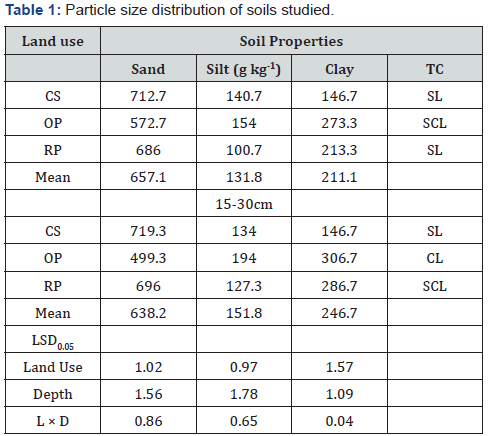
CS: Cassava cultivated land; OP: Oil palm plantation; RP: Rubber plantation; L × D: Interaction of land use × depth
The increase in clay with soil depth maybe due to translocation [20], dissolution and leaching of clay materials as a result of intense torrential rainfall, argillation of clay, lessivage and sorting of soil materials [21]. Jaiyeoba [21], observed that increased clay contents at lower depths were due to increase in cultivation. This may be as a result of either increase of clay translocation from the surface to subsurface horizons or removal of clay from the surface by runoff.
Bulk density, total porosity and saturated hydraulic conductivity
The bulk density, total porosity and saturated hydraulic conductivity of the soils studied are shown in Table 2. At the two depths of 0–15 and 15–30cm, cassava cultivated land had the highest bulk density with a value of 1.69 and 1.90Mg m-3, respectively. The lowest bulk density was observed in oil palm plantation (OP) at the two depths with values ranging from 1.39 to 1.62Mg m-3. With regard to porosity, OP had the highest at both depths (47.60% and 38.77%). Cassava cultivated land (CS) was observed to have the lowest total porosity (36.40% and 28.30%) at both depths. Oil palm plantation had the fastest saturated hydraulic conductivity ranging from 0 .46 to 0.77cm min-1 at both depths while cassava cultivated land had the slowest of 0.12 to 0.19cm min-1.
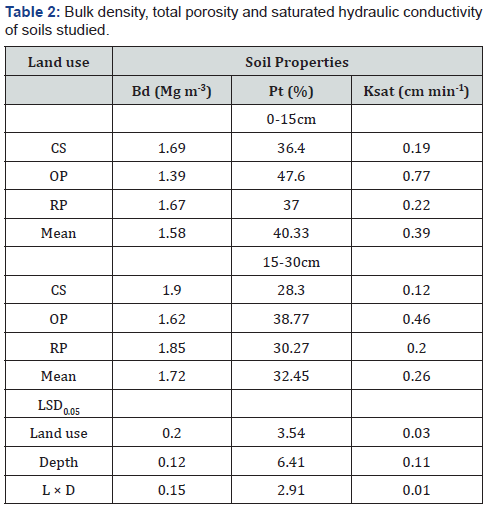
Generally, the bulk density of the soils increased significantly (p≤0.05) with depth, whereas total porosity and saturated hydraulic conductivity decreased significantly (p≤0.05) with depth (Table 2). These observations reflected the influence of organic matter on the parameters. With reduced organic matter content, bulk density increased while total porosity decreased resulting to a reduction in saturated hydraulic conductivity [22].
As shown in Table 2, and with reference to the two depths, the values indicated that bulk density, total porosity and saturated hydraulic conductivity were significantly (p≤0.05) different. With reference to land use systems in both depths, the bulk density of CS was significantly (p≤0.05) higher than OP and RP. The porosity under CS were significantly (p≤0.05) different from OP and RP at both depths. The saturated hydraulic conductivity under CS was significantly (p<0.05) slower than OP and RP at both depths, whereas OP was significantly (p<0.05) faster than CS and RP.
The variation in bulk density and total porosity may be attributed to the level of organic matter in the soil [23]. The high bulk density, low porosity, slow saturated hydraulic conductivity and infiltration rate observed under CS were similar to the findings of Ahukaemere et al. [24]. He observed consistently higher bulk density in continuously cultivated land than in oil palm plantation. The low bulk density and high porosity with a fast saturated hydraulic conductivity observed under OP may be as a result of the high organic matter content of the OP. This concurred with the findings of Onweremadu & Mbah [25] who reported that the high level of organic matter in oil palm plantation led to low bulk density, high total volume and favoured transmission of water under saturated conditions. The slow saturated hydraulic conductivity observed under CC may be attributed to the low mean weight diameter, high bulk density and the mechanical disruption of the pore arrangements by tillage [26]. As organic matter decreased from OP to CS, the total porosity reduced. This was consistent with the observations of Oguike et al. [27].
Aggregate stability
The aggregate stability of soils studied are shown in Table 3. At both depths of 0-15 and 15-30cm, OP was observed to have the most stable aggregates at both depths with the highest mean weight diameter (MWD) which ranged from 2.189 to 2.844mm. cassava cultivated land (CS) was the least aggregated and also showed the greatest tendency to disperse at both depths with the lowest MWD and highest dispersion ratio (DR). The values ranged from 0.768 to 0.825mm for MWD and 24.470 to 28.330% for DR. Oil palm plantation showed the lowest tendency to disperse with the lowest dispersion ratio at both depths. The values ranged from 15.970 to 19.320%. Aggregated silt + clay from the different land use systems were significantly different (p≤0.05) at 0-15cm depth whereas at the 15-30cm depth, soils from CS and RP were statistically similar and less aggregated than soils from OP. The CS and RP soil showed the least resistance to dispersion as revealed by the high CDI and low ASC and CFI values. Also, at 15-30cm depth soils from CS and RP were statistically similar with respect to CDI. This may be due to the increase in clay content of soils under the land use systems with depth.
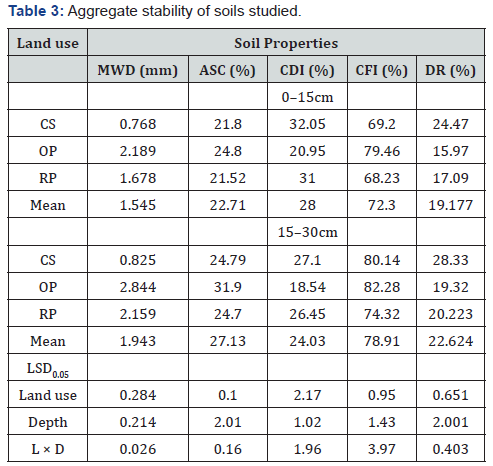
CS: Cassava cultivated land; OP: Oil palm plantation; RP: Rubber plantation; L × D: Interaction of land use × depth; MWD: Mean weight diameter: ASC: Aggregated silt + clay; CDI: Clay dispersion index; CFI: Clay flocculation index; DR: Dispersion ratio.
Significant variations were also observed in the flocculation abilities of the soils. Clay flocculation at 0-1cm depth was found to increase in the order RP, CS and OP. This may be as a result of the proportionate increase in clay and silt contents. However, at 15- 30cm depth, the flocculation ability of soils formed over CS and OP were statistically similar. The exhibition of good structural abilities observed in soils of OP and RP were due to their increased organic matter contents [28] while the reduced aggregation noticed in soil from CS was a result of its reduced OM content [29,30].
At the colloidal level, with regard to 2 depths, the soils formed over OP was the most aggregated and least dispersed as indicated by aggregation (ASC), flocculation (CFI) and dispersion (CDI) indices. Comparatively, soil of CS was the least aggregated at both depths. Sesquioxides and clay mineralogy (not determined) may have played dominant roles in the aggregate stability of the soils.
The macro aggregation measured with MWD and the dispersion of soils (DR) increased significantly (p≤0.05) with depth. As shown in Table 3 and with regards to depth, the means indicated significant (p≤0.05) differences in both at the macro and micro levels. With reference to land use systems in both depths (Table 3), the MWD of cassava cultivated land (CS) was significantly (p≤0.05) lower than OP and RD. At both depths, mean weight diameter of OP was significantly higher than CS and RP. The MWD of CS was significantly (p≤0.05) different from the other land use systems at both depths. At the macro aggregation level, OP were better than the other land use systems. This observation supported the findings of Celik [26], who reported that mean weight diameter of soil aggregates were significantly greater in oil palm plantation, than in cassava cultivated land and rubber plantation.
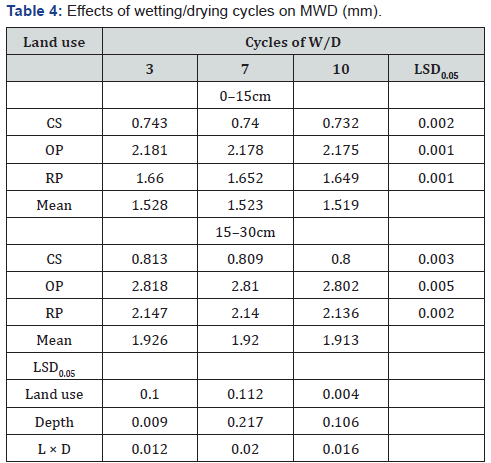
CS: Cassava cultivated land; OP: Oil palm plantation; RP: Rubber plantation; L × D: Interaction of land use × depth.
The effect of wetting and drying cycle on the mean weight diameter of the soil studied is shown in Table 4. The table showed that the W/D cycle 3 under oil palm plantation had the highest mean weight diameter (2.181 and 2.811mm) at both depths, while W/D cycle 10 under cassava cultivated land recorded the lowest (0.732 and 0.800mm) at both depths. Generally, the mean weight diameter of the soils increased significantly (p≤0.05) with depth after the wetting and drying cycle. As shown in Table 4, and with reference to the two depths, the values indicated that mean weight diameter were significantly (p≤0.05) different. With reference to land use systems in both depths, mean weight diameter of CS was significantly (p≤0.05) lower than OP and RP after the wetting and drying cycle. However, with respect to the wetting and drying cycles, the mean weight diameter under W/D cycle 3 was significantly (p≤0.05) higher than other cycles.
The low MWD observed in CS may be attributed to tillage with traditional implements and clean weeding, together with reduced organic matter [31]. Cultivation break up soil aggregates and expose previously inaccessible organic matter to microbial attack and accelerates decomposition and mineralization of organic matter [32]. The high value of MWD observed under OP may be attributed to the high organic matter contents of the soils (Table 4). This may be associated with increase in the percentage of binding materials (polysaccharides, humic and humin) contained in the organic materials which enable soil particles to aggregate with each other [33,34]. The higher DR observed in CS may be attributed to the colloidal nature of clay which could promote the poor aggregation in the soils [35].
Organic matter, available phosphorus, total nitrogen and pH of soils studied
The organic matter, available phosphorus, total nitrogen and pH of the soils studied are shown in Table 5. At both depths of 0-15 and 15-30cm, oil palm plantation (OP) was observed to have the highest organic matter at both depths with values 28.300 and 24.000g kg-1, respectively. The cassava cultivated land (CS) was observed to have the lowest organic matter at both depths with values 25.900 and 23.400g kg-1. Under available phosphorus, CS recorded the highest at both depths with values 23.667 and 15.700Mg Kg-1, while oil palm plantation (OP) was observed to have the lowest available phosphorus (21.000 and 13.833Mg Kg-1) at both depths. At the depths of 0-15cm and 15-30cm, OP recorded the highest total nitrogen (0.170 and 0.129%) while CS recorded the lowest total nitrogen (0.139 and 0.116%). With regards to pH at both depths, rubber plantation (RP) had the highest pH values ranging from 5.500 to 6.067, while cassava cultivated land (CS) was observed to have the lowest pH values ranging from 4.800 to 5.633. With respect to both depths, cassava cultivated land (CS) was very low in organic matter with a strongly acidic reaction whereas rubber plantation (RP) was high in organic matter with a slightly acidic soil reaction [36]. However, the soil studied under oil palm plantation (OP), was high in organic matter having a moderate acidic soil reaction [36].
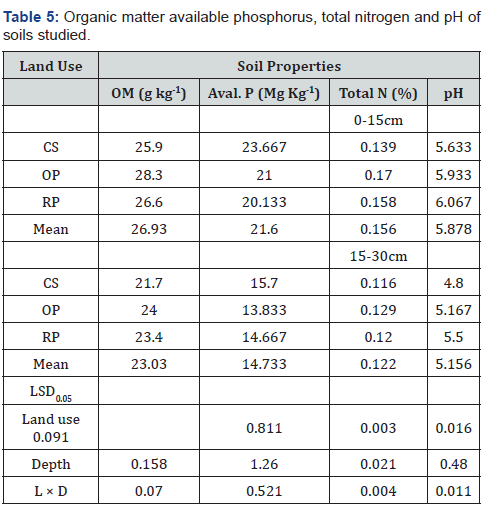
CS: Cassava cultivated land; OP: Oil palm plantation; RP: Rubber plantation; L × D: Interaction of land use × depth.
As shown in Table 5 and referring to depth, the means indicated significant (p≤0.05) decrease in organic matter, available phosphorus, total nitrogen and pH. With respect to land use systems in both depths, the organic matter, total nitrogen and pH of cassava cultivated land were significantly (p≤0.05) lower than the other land use systems. The decrease in organic matter content with soil depth may be attributed to the continuous accumulation of undecayed and partially decomposed plant and animal residues on the surface soil [37]. The high organic matter observed under OP and RP may be attributed to the presence of litter falls and roots [38]. The low organic matter observed in cassava cultivated land may be attributed to the effects of continuous cultivation that aggravates organic matter oxidation [38-40].
The decrease in pH with increase in soil depth may be as a result of larger organic matter content observed at the top soils which helped to bind tightly with aluminium ions and reduce their activity in the soil solution which thereby raise soil pH and reduce acidity [37]. The decrease of soil pH with depth might also be attributed to the increase in clay contents with depth which have the tendency to furnish hydrogen ions from clay colloidal surface to the solution thereby reducing soil pH. The slightly acidic and moderately acidic nature of the soil under OP and RP could be attributed to the high exchangeable bases [38].
Correlation matrix of the soil properties studied
The correlation of soil properties studied under cassava cultivated land is shown in Table 6. The Table showed that aggregate stability was strongly correlated with clay contents, bulk density, total porosity, ASC, CFI and organic matter. The macro aggregation measured with mean weight diameter (MWD) positively, correlated, significantly with clay content (r=0.643), ASC (r=0.759), CFI (r=0.611) and organic matter (r=0.853). Dispersion ratio was observed to have a positive, significant, correlation with bulk density (r=0.629) and a negative, significant, correlation with total porosity (r=-0.631), ASC (r=-0.861) and CFI (r=-0.500). The indication was that mean weight diameter increased as clay contents, organic matter, ASC and CFI increased, resulting to better aggregation of the soil. However, dispersion ratio increased as bulk density increased with a corresponding decrease in total porosity, ASC and CFI.
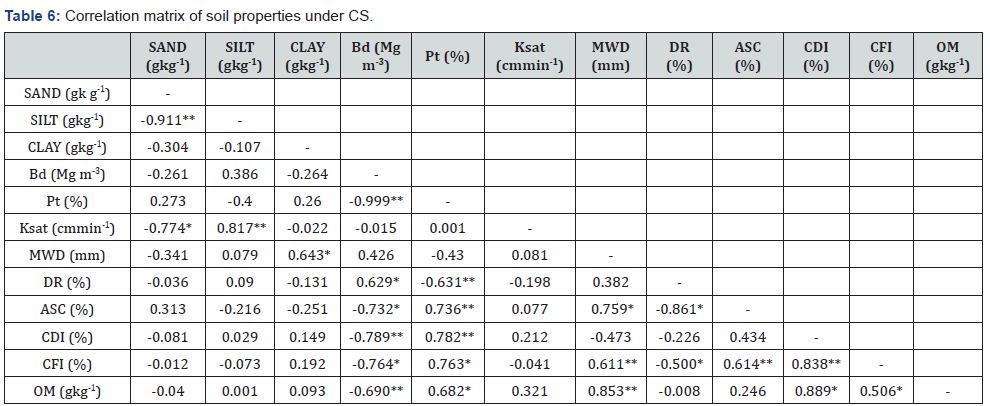
** Correlation is significant at the 0.01 level.
* Correlation is significant at the 0.05 levels
Table 7 revealed that aggregate stability strongly correlated with sand, silt, clay, organic matter, ASC and CFI under the oil palm plantation. Under this land use, MWD negatively correlated significantly with sand (r=-0.74) and positively correlated significantly with clay (r=0.95) and organic matter (r=0.95). The indication was that mean weight diameter increased as sand decreased with an increase in clay content and organic matter increased. Dispersion ratio representing micro aggregation negatively, correlated with sand (r= -0.61), ASC (r=-0.68), total porosity (r=-0.50) and CFI (r=-0.71). This indicated that increase in sand particles, ASC, total porosity and CFI decreased the soil micro aggregation.
The correlation of soil properties studied under rubber plantation is shown in Table 8. The Table showed that aggregate stability was strongly correlated with particle size, bulk density, total porosity and organic matter. The macro aggregation measured with mean weight diameter (MWD) positively, correlated, significantly with clay content (r=0.872), total porosity (r=0.828) and organic matter (r=0.841). Mean weight diameter negatively, correlated, significantly with sand content (r=-0.509), silt content (r=-0.565), bulk density (r=-0.806) and CDI (r=-0.526). Dispersion ratio was observed to have a positive, significant, correlation with sand content (r=0.556), silt content (r=0.531), bulk density (r=0.873) and a negative, significant, correlation with clay content (r=-0.825), total porosity (r=-0.874), mean weight diameter (r=- 0.976) and organic matter (r=-0.858). The indication was that mean weight diameter increased as clay contents, organic matter and total porosity increased, resulting to better aggregation of the soil. However, dispersion ratio increased as sand and silt contents and bulk density increased with a corresponding decrease in clay content, total porosity and organic matter content.
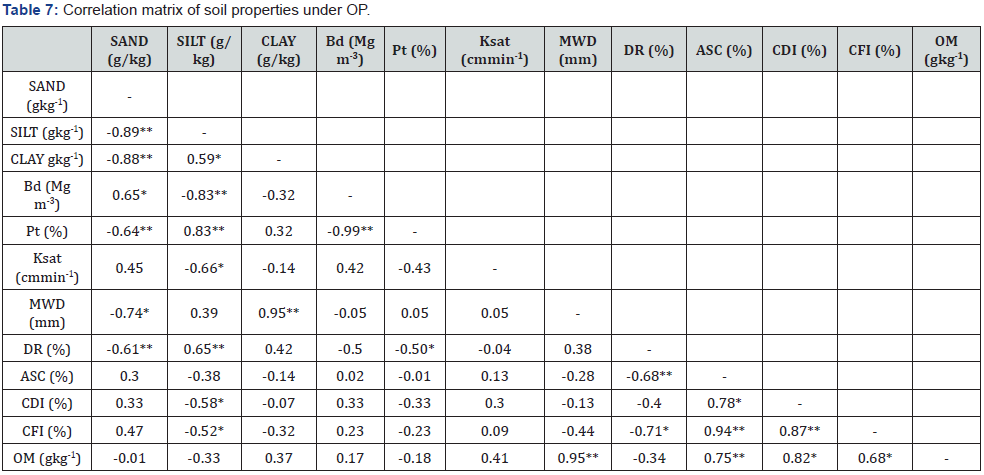
** Correlation is significant at the 0.01 level.
* Correlation is significant at the 0.05 level.
The influence of clay on soil aggregate stability maybe attributed to its ability to form slurry when in contact with moisture. Zhang & Horn [41] who made similar observation reported that clay content of soils determined to a large extent, the aggregate stability of the soil. The positive relationship between organic matter and mean weight diameter may be attributed to the prevalence of binding materials (polysaccharides, humic and humin) available in organic materials enabling soil particles to aggregate with each other [34]. This corroborated with the findings of Beata et al. [42], who reported that as clay content and organic matter increased, the soil became more structurally aggregated [43-50].
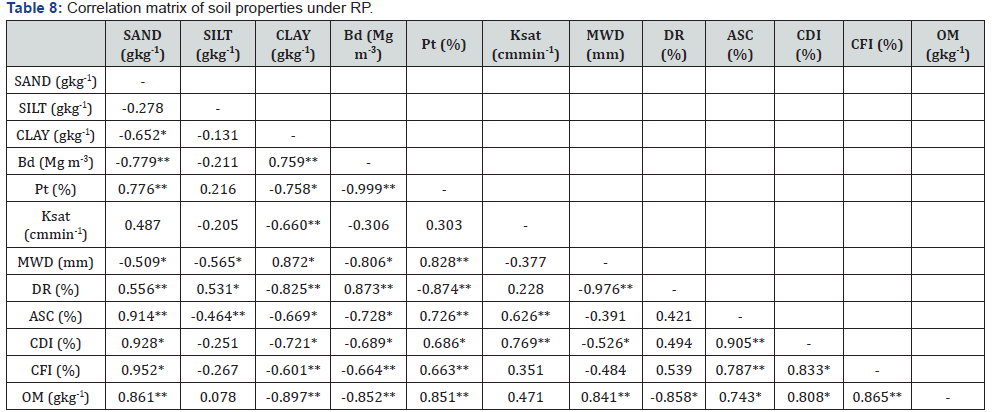
** Correlation is significant at the 0.01 level.
* Correlation is significant at the 0.05 level.
Conclusion
Soils of different land use systems; cassava cultivated land (CS), oil palm plantation (OP), and rubber plantation (RP) were studied at Ikpe Ikot Nkon, Ini Local Government Area in Akwa Ibom State. The principal objective was to compare the impact of each land use system on the aggregate stability and selected chemical properties of the soil. The relationship between selected soil properties and the aggregate stability was also determined in the study. The results of the selected properties under study showed that the soil properties varied with different land use systems. The particle size distribution recorded that sand-sized particles dominated other fractions. In cassava cultivated land and rubber plantation (15–30cm), the textural class was sandy loam (SL), while other land use systems were dominated by sandy clay loam (SCL) and clay loam (CL). Porosity varied with bulk density in the land use systems. High total porosity and low bulk density were observed in oil palm plantation (OP), while cassava cultivated land (CS) had high bulk density and low total porosity. Saturated hydraulic conductivity of the soils varied across the land use systems with organic matter playing an important role in the soil moisture conduction against a hydraulic gradient. Soils under oil palm were more structurally aggregated than others. Dispersion ratio of soils was high in cassava cultivated land (CS) which showed that the soils are highly erodible. The pH of the soils studied ranged from very strongly acidic to moderately acidic. Organic matter was generally low in cassava cultivated land (CS) but high in oil palm plantation (OP). Soils under from OP and RP exhibited higher structural development and better OM contents than the soils under CS. Therefore, management practices such as heavy OM application to stabilize soils under CS against erosion and other mechanical manipulations should be encouraged. This will enhance sustainable utilization of such soils.
To
Know More About Agricultural Research & Technology: Open Access Journal Please
Click on:
https://juniperpublishers.com/artoaj/index.php
To Know More About Open
Access Journals Publishers Please Click on: Juniper
Publishers





No comments:
Post a Comment